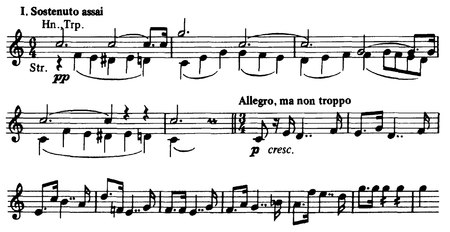Movements
This section possibly contains original research .(February 2022) |
| External audio | |
|---|---|
| Performed by the Berlin Philharmonic under Herbert von Karajan | |
The symphony is written in the traditional four-movement form, and as often in the nineteenth century the Scherzo precedes the Adagio. All four movements are in C major, except the first part of the slow movement (in C minor); the work is thus homotonal:
- Sostenuto assai — Allegro, ma non troppo
- The first movement begins with a slow brass chorale, elements of which recur through the piece. (Schumann wrote the Six Organ Fugues on B-A-C-H, Op. 60, just before this symphony, and this preoccupation with Bach suggests a chorale prelude, a quintessential Bachian genre, in the texture and feeling of the symphony's opening. Possibly, too, Schumann was inspired by the sombre brass fanfare at the start of Haydn's 'London Symphony' (No. 104), which uses the same tonic-dominant progression.) The following Sonata-Allegro is dramatic and turbulent. It is characterized by sharp rhythmic formulae (double-dotted rhythms) and by the masterly transformation of the material of the Introduction.
-

- Scherzo: Allegro vivace
- The second movement is a scherzo in C major with two trios, whose main portion strongly emphasizes the diminished chord—its characteristic gesture being a rapid and playful resolution of this chord over unstable harmony. The second trio employs the B-A-C-H motif in the context of flowing eighth notes reminiscent of the Baroque, further suggesting that Bach remained on Schumann's mind after the completion of his Op. 60.
-

- Adagio espressivo
- The Adagio espressivo is a sonata movement in C minor, with the character of an elegy, its middle section strongly contrapuntal in texture.
-

- Allegro molto vivace
- The finale is in a very freely treated sonata form, its second theme related to the opening theme of the Adagio. Later in the movement at bar 280, a new theme appears: this theme has, as its sources of inspiration, the last song from Beethoven's cycle "An die ferne Geliebte" (cf. also Schumann's Piano Fantasy in C, Op. 17 and String Quartet op. 41/2), and Beethoven's "Ode to Joy." The coda of the Finale recalls the material from the Introduction, thereby thematically spanning the entire work.
-

A typical performance lasts between 35 and 40 minutes. It is scored for an orchestra consisting of two flutes, two oboes, two clarinets (in B♭), two bassoons, two French horns (in C), two trumpets (in C), three trombones (alto, tenor, and bass), timpani, and strings.



